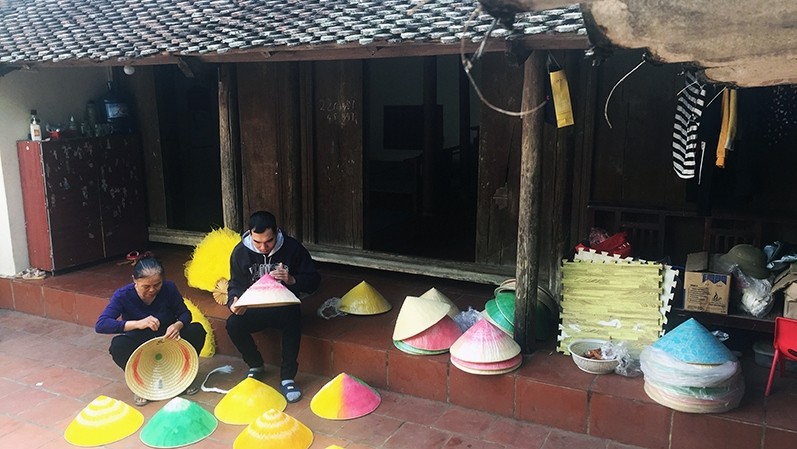During the social distancing period in early 2021, Dung was stuck in his hometown of Dai Dong village. One day while he sat under a Bodhi tree, he picked up a fallen leaf and observed it carefully under the sunlight. He found that the Bodhi leaf has an interlaced skeleton structure, much like a spider's web, making it strong enough to create several different products.
He came up with the idea of embalming Bodhi leaves, making them everlasting. He first tried soaking the leaves in limewater, to remove the outer layer of the leaves. However, it took up to 60 days to remove the leaves’ tissue from the skeleton structure using this method. The method also made the remaining leaves’ veins softer, with an unpleasant smell.
Therefore, Dung had to research further, to find a way to reduce the time and increase the toughness and strength of the Bodhi leaf. In addition to seeking experience from People’s Artisan Nguyen Ba Muu, who succeeded in embalming flowers, Dung had to broaden his knowledge of biochemistry, especially chemical reactions, in order to work toward new soaking solutions for the leaves.
After dozens of experiments, Dung succeeded in shortening the time to 30 days, and then six days, and finally, only one day. The finished skeleton leaves are durable, while the petiole and veins are still kept intact.
The next difficult task was what to do with the processed Bodhi leaves. As the trees are often planted in rural areas, to provide shade, Dung envisioned the idea of making conical hats from the Bodhi leaves.

Bodhi leaf conical hats (Photo: vnexpress)
When it’s part of the tree, Bodhi leaves contribute to giving shade to life. When it’s used as material to make conical hats, it has transformed into a different form, but still continues that honourable mission of providing shade for people. And most of all, the conical hat is a symbolic product of the country and the people of Vietnam.
Bodhi leaves have been used as paintings and souvenirs, but Dung is the first one to put them together on the conical hats.
To turn his idea into reality, Dung came to Coc hamlet, Phu My village in Ngoc My commune, Quoc Oai district, Hanoi, where villagers have practiced the traditional craft of conical hat making for generations. There, he was introduced to Doan Thi Thai, who has had half a century working with conical hats.
However, the Bodhi leaves are smaller and more fragile than palm leaves, which are often used to make conical hats, therefore it was difficult for Thai to sew the leaves together.
A Bodhi-leaf conical hat is made up of around 500 leaves. The first attempt ended with failure, which meant so much effort and thousands of leaves became useless. Without being discouraged, Dung encouraged the veteran artisan to try a new sewing technique, to help the product come together.
After five attempts, with many months passed, the completed conical hats were formed amidst the joy of Thai and Dung. A Bodhi leaf conical hat is formed from nine layers of leaves, which are segregated in varied sizes. The nine layers are stacked together like a blooming lotus.
“The number nine is also a spiritual number in the Vietnamese people’s belief, as it represents benevolence, peace and luck,” Dung said.
 |
Kieu Cao Dung and his products made from Bodhi leaves (Photo: NDO/Phong Chuong)
Following their success, Dung and his colleagues are working on other products made from Bodhi leaf skeletons, such as leaf fans and lanterns. The team pays great attention to using environmentally friendly materials.
Dung registered a trademark for his Bodhi leaf hat, and he is working to commercialise his products, to boost sales and generate stable income for employees. According to Doan Thi Thai, the artisan is paid 250,000 VND for making a Bodhi leaf conical hat, which is valued at 550,000 VND. This income is a well-paid job.
Dung’s tireless efforts have initially paid off, since his products have been highly appreciated by customers, with high marketability. He has received an offer from a Japan-based online retail site, for handmade products. He was also invited to sell his products at famous pagodas, including Huong and Bai Dinh pagodas.
In the days to come, he plans to launch his products on online trading platforms, which are very important selling channels, particularly in the context of the COVID-19 pandemic, in a bid to reach international customers and advertise Vietnamese traditional products to the world.
















